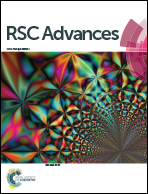Insights into the hydrogenation mechanism of nitrobenzene to aniline on Pd3/Pt(111): a density functional theory study
Abstract
Periodic density functional theory (DFT) calculations are performed to systematically investigate the adsorption and hydrogenation mechanism of nitrobenzene to aniline on Pd3/Pt(111) bimetallic surface. The adsorption energies under the most stable configuration of the pertinent species are analyzed, and the activation energies and reaction energies of the possible elementary reactions are obtained. Our calculation results show that the adsorption at the Pd-top-top site through O–O atom is the most stable configuration when the nitrobenzene is perpendicular to the Pd3/Pt(111) bimetallic surface. The hydrogenation mechanism of nitrobenzene on Pd3/Pt(111) bimetallic surface preferentially follows the direct hydrogenation route and fits best the Jackson reaction mechanism. Furthermore, the hydrogenation processes are almost exothermic and the hydrogenation of phenylhydroxylamine is considered as the rate-limiting step with an energetic barrier of 39.89 kcal mol−1.


 Please wait while we load your content...
Please wait while we load your content...